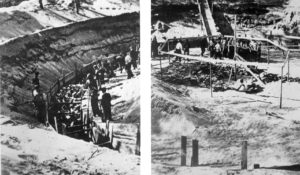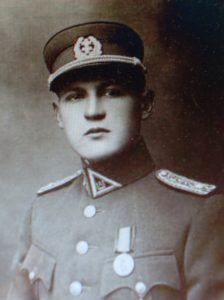When Nazi Germany attacked the Soviet Union on 22 June 1941, Lithuanians began the anti-Soviet June Uprising, organized by the Lithuanian Activist Front. Lithuanians proclaimed independence and organized the Provisional Government of Lithuania. This government quickly self-disbanded. Lithuania became part of the Reichskommissariat Ostland, German civil administration.

By 1 December 1941, over 120,000 Lithuanian Jews, or 91–95% of Lithuania’s pre-war Jewish community, had been killed. Nearly 100,000 Jews, Poles, Russians and Lithuanians were murdered at Paneriai. However, thousands of Lithuanian families risking their lives also protected Jews from the Holocaust. Israel has recognized 893 Lithuanians (as of 1 January 2018) as Righteous Among the Nations for risking their lives to save Jews during the Holocaust.
1944–1990:
After the retreat of the German armed forces, the Soviets reestablished their control of Lithuania in July–October 1944. The massive deportations to Siberia were resumed and lasted until the death of Stalin in 1953. Antanas Sniečkus, the leader of the Communist Party of Lithuania from 1940 to 1974, supervised the arrests and deportations. All Lithuanian national symbols were banned. Under the pretext of Lithuania’s economic recovery, the Moscow authorities encouraged the migration of workers and other specialists to Lithuania with the intention to further integrate Lithuania into the Soviet Union and to develop the country’s industry. At the same time, Lithuanians were lured to work in the USSR by promising them all the privileges of settling in a new place.

The second Soviet occupation was accompanied by the guerrilla warfare of the Lithuanian population, which took place in 1944–1953. It sought to restore an independent state of Lithuania, to consolidate democracy by destroying communism in the country, returning national values and the freedom of religion. About 50,000 Lithuanians took to the forests and fought Soviet occupants with a gun in their hands. In the later stages of the partisan war, Lithuanians formed the Union of Lithuanian Freedom Fighters and its leader Jonas Žemaitis (codename Vytautas) was posthumously recognized as the president of Lithuania. Despite the fact that the guerrilla warfare did not achieve its goal of liberating Lithuania and that it resulted in more than 20,000 deaths, the armed resistance de facto demonstrated that Lithuania did not voluntarily join the USSR and it also legitimized the will of the people of Lithuania to be independent. Lithuanian courts and the ECHR both treat the Soviets’ annihilation of the Lithuanian partisans as a genocide.

The Helsinki Group, which was founded in Lithuania after the international conference in Helsinki (Finland), where the post-WWII borders were acknowledged, announced a declaration for Lithuania’s independence on foreign radio station. The Helsinki Group informed the Western world about the situation in the Soviet Lithuania and violations of human rights. With the beginning of the increased openness and transparency in government institutions and activities (glasnost) in the Soviet Union, on 3 June 1988, the Sąjūdis was established in Lithuania. Very soon it began to seek country’s independence. Vytautas Landsbergis became movement’s leader.
